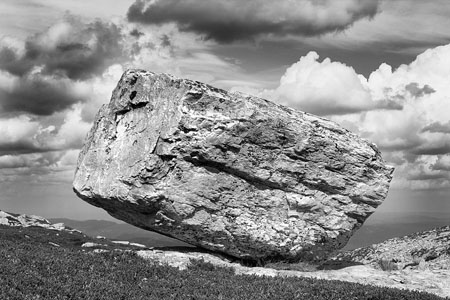 I have spent some 20 to 30
days a year (mainly weekends) in the north eastern parts
of Blefjell since 1986, but my photographic project of
Blefjell is far from finished. It’s really just
begun. The real challenge has been the excess of details
everywhere. I have problems isolating the subjects and
creating interesting backgrounds. Colour photography gave
a new dimension to some of the photographs, but not
sufficiently so to merit a full scale colour project. I
have now started to give the photographs a new dimension
by special treatment in Black & White to get rid of
some of the details, and emphasizing the landscape forms
and general texture. But perhaps most of all I try to
focus on the special lighting that exists in all seasons
and the general mood that the landscape transmit to me
there and then.
I have spent some 20 to 30
days a year (mainly weekends) in the north eastern parts
of Blefjell since 1986, but my photographic project of
Blefjell is far from finished. It’s really just
begun. The real challenge has been the excess of details
everywhere. I have problems isolating the subjects and
creating interesting backgrounds. Colour photography gave
a new dimension to some of the photographs, but not
sufficiently so to merit a full scale colour project. I
have now started to give the photographs a new dimension
by special treatment in Black & White to get rid of
some of the details, and emphasizing the landscape forms
and general texture. But perhaps most of all I try to
focus on the special lighting that exists in all seasons
and the general mood that the landscape transmit to me
there and then.
The mountain range of Blefjell is situated only some 120 km west of Oslo. Here walkers and people skiing can enjoy an almost 20 km continuous high mountain ridge. The ridge starts with Bletoppen (1342 meters) just above Bolkesjø and continues straight north all the way to Viermyrnuten (1213 meters) also called Blenuten, from where you look directly down into the nearby lake of Sørkjevatn and you see further along to the Hardangervidda, which begins only another 1 hour walk away. (Hardangervidda is the largest high mountain plateau in Europe.) Turistforeningen (Norwegian association for hiking and cross country skiing) has 3 self service mountain cottages catering for overnight stays along the Blefjell ridge: Sigrisbu, Eiriksbu and Øvre Fjellstul. But you need to bring your own food.
Blefjell is 20 km wide in the southern parts and about 10 km wide up north and this area is divided among 5 communes: Flesberg, Rollag, Tinn, Notodden and Kongsberg. West of the mountain ridge, the landscape is very steep and falls down towards the long narrow lake of Tinnsjøen. In the east, however, you have a wide mountain plateau where the altitude varies between 800 and 900 meters. In these parts, the timber was early exploited for use in the large silver mines of Kongsberg and the consequence to-day is that this plateau has very little forest and mainly small trees here and there. For this reason this plateau resemble a high mountain plateau and is very popular with hikers and skiiers, especially in winter time, when you have large white expanses as far as the eyes can see.